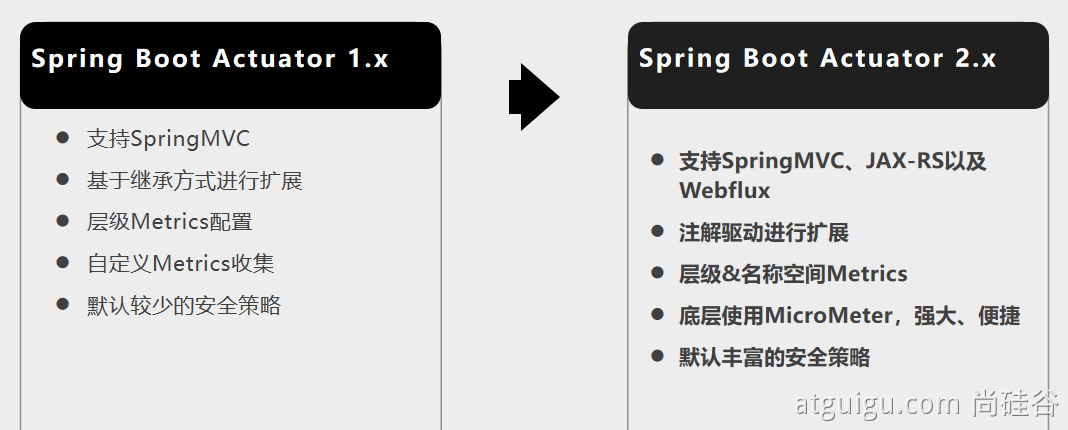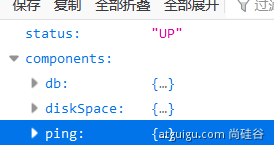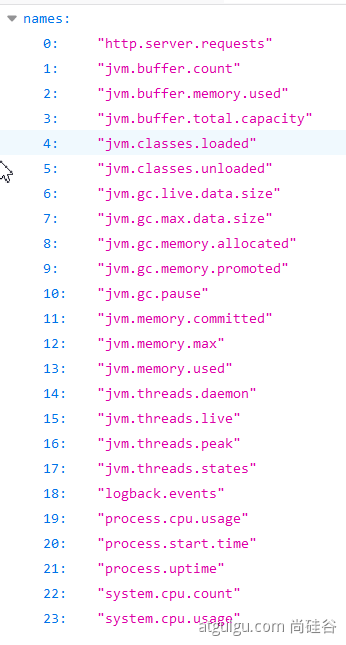21、指标监控

文章目录
- 1、SpringBoot Actuator
-
- 1、简介
- 2、1.x与2.x的不同
- 3、如何使用
- 4、可视化
- 2、Actuator Endpoint
-
- 1、最常使用的端点
- 2、Health Endpoint
- 3、Metrics Endpoint
- 4、管理Endpoints
-
- 1、开启与禁用Endpoints
- 2、暴露Endpoints
- 3、定制 Endpoint
-
- 1、定制 Health 信息
- 2、定制info信息
-
- 1、编写配置文件
- 2、编写InfoContributor
- 3、定制Metrics信息
-
- 1、SpringBoot支持自动适配的Metrics
- 2、增加定制Metrics
- 4、定制Endpoint
【尚硅谷】SpringBoot2零基础入门教程-讲师:雷丰阳
笔记
路还在继续,梦还在期许
1、SpringBoot Actuator
1、简介
未来每一个微服务在云上部署以后,我们都需要对其进行监控、追踪、审计、控制等。SpringBoot就抽取了Actuator场景,使得我们每个微服务快速引用即可获得生产级别的应用监控、审计等功能。
<dependency><groupId>org.springframework.boot</groupId><artifactId>spring-boot-starter-actuator</artifactId>
</dependency>

2、1.x与2.x的不同

3、如何使用
● 引入场景
● 访问 http://localhost:8080/actuator/
● 暴露所有监控信息为HTTP
management:endpoints:enabled-by-default: true #暴露所有端点信息web:exposure:include: '*' #以web方式暴露
● 测试
http://localhost:8080/actuator/beans
http://localhost:8080/actuator/configprops
http://localhost:8080/actuator/metrics
http://localhost:8080/actuator/metrics/jvm.gc.pause
http://localhost:8080/actuator/endpointName/detailPath
。。。。。。
4、可视化
https://github.com/codecentric/spring-boot-admin
2、Actuator Endpoint
1、最常使用的端点
| ID | 描述 |
|---|---|
| auditevents | 暴露当前应用程序的审核事件信息。需要一个AuditEventRepository组件。 |
| beans | 显示应用程序中所有Spring Bean的完整列表。 |
| caches | 暴露可用的缓存。 |
| conditions | 显示自动配置的所有条件信息,包括匹配或不匹配的原因。 |
| configprops | 显示所有@ConfigurationProperties。 |
| env | 暴露Spring的属性ConfigurableEnvironment |
| flyway | 显示已应用的所有Flyway数据库迁移。 需要一个或多个Flyway组件。 |
| health | 显示应用程序运行状况信息。 |
| httptrace | 显示HTTP跟踪信息(默认情况下,最近100个HTTP请求-响应)。 需要一个HttpTraceRepository组件。 |
| info | 显示应用程序信息。 |
| integrationgraph | 显示Spring integrationgraph 。 需要依赖spring-integration-core。 |
| loggers | 显示和修改应用程序中日志的配置。 |
| liquibase | 显示已应用的所有Liquibase数据库迁移。 需要一个或多个Liquibase组件。 |
| metrics | 显示当前应用程序的“指标”信息。 |
| mappings | 显示所有@RequestMapping路径列表。 |
| scheduledtasks | 显示应用程序中的计划任务。 |
| sessions | 允许从Spring Session支持的会话存储中检索和删除用户会话。 需要使用Spring Session的基于Servlet的Web应用程序。 |
| shutdown | 使应用程序正常关闭。 默认禁用。 |
| startup | ringApplication进行配置BufferingApplicationStartup。 |
| threaddump | 执行线程转储。 |
如果您的应用程序是Web应用程序(Spring MVC,Spring WebFlux或Jersey),则可以使用以下附加端点:
| ID | 描述 |
|---|---|
| heapdump | 返回hprof堆转储文件。 |
| jolokia | 通过HTTP暴露JMX bean(需要引入Jolokia,不适用于WebFlux)。 需要引入依赖jolokia-core。 |
| logfile | 返回日志文件的内容(如果已设置logging.file.name或logging.file.path属性)。 支持使用HTTPRange标头来检索部分日志文件的内容。 |
| prometheus | 以Prometheus服务器可以抓取的格式公开指标。 需要依赖micrometer-registry-prometheus。 |
最常用的Endpoint
● Health:监控状况
● Metrics:运行时指标
● Loggers:日志记录
2、Health Endpoint
健康检查端点,我们一般用于在云平台,平台会定时的检查应用的健康状况,我们就需要Health Endpoint可以为平台返回当前应用的一系列组件健康状况的集合。
重要的几点:
● health endpoint返回的结果,应该是一系列健康检查后的一个汇总报告
● 很多的健康检查默认已经自动配置好了,比如:数据库、redis等
● 可以很容易的添加自定义的健康检查机制

3、Metrics Endpoint
提供详细的、层级的、空间指标信息,这些信息可以被pull(主动推送)或者push(被动获取)方式得到;
● 通过Metrics对接多种监控系统
● 简化核心Metrics开发
● 添加自定义Metrics或者扩展已有Metrics

4、管理Endpoints
1、开启与禁用Endpoints
● 默认所有的Endpoint除过shutdown都是开启的。
● 需要开启或者禁用某个Endpoint。配置模式为 management.endpoint..enabled = true
management:endpoint:beans:enabled: true
或者禁用所有的Endpoint然后手动开启指定的Endpoint
management:endpoints:enabled-by-default: falseendpoint:beans:enabled: truehealth:enabled: true
2、暴露Endpoints
支持的暴露方式
● HTTP:默认只暴露health和info Endpoint
● JMX:默认暴露所有Endpoint
● 除过health和info,剩下的Endpoint都应该进行保护访问。如果引入SpringSecurity,则会默认配置安全访问规则
| ID | JMX | Web |
|---|---|---|
| auditevents | Yes | No |
| beans | Yes | No |
| caches | Yes | No |
| conditions | Yes | No |
| configprops | Yes | No |
| env | Yes | No |
| flyway | Yes | Yes |
| health | N/A | No |
| httptrace | Yes | No |
| info | Yes | Yes |
| integrationgraph | Yes | No |
| jolokia | N/A | No |
| logfile | N/A | No |
| loggers | Yes | No |
| liquibase | Yes | No |
| metrics | Yes | No |
| mappings | Yes | No |
| prometheus | N/A | No |
| scheduledtasks | Yes | No |
| sessions | Yes | No |
| shutdown | Yes | No |
| startup | Yes | No |
| threaddump | Yes | No |
3、定制 Endpoint
1、定制 Health 信息
import org.springframework.boot.actuate.health.Health;
import org.springframework.boot.actuate.health.HealthIndicator;
import org.springframework.stereotype.Component;@Component
public class MyHealthIndicator implements HealthIndicator {@Overridepublic Health health() {int errorCode = check(); // perform some specific health checkif (errorCode != 0) {return Health.down().withDetail("Error Code", errorCode).build();}return Health.up().build();}}构建Health
Health build = Health.down().withDetail("msg", "error service").withDetail("code", "500").withException(new RuntimeException()).build();
management:health:enabled: trueshow-details: always #总是显示详细信息。可显示每个模块的状态信息
@Component
public class MyComHealthIndicator extends AbstractHealthIndicator {/* 真实的检查方法* @param builder* @throws Exception*/@Overrideprotected void doHealthCheck(Health.Builder builder) throws Exception {//mongodb。 获取连接进行测试Map<String,Object> map = new HashMap<>();// 检查完成if(1 == 2){
// builder.up(); //健康builder.status(Status.UP);map.put("count",1);map.put("ms",100);}else {
// builder.down();builder.status(Status.OUT_OF_SERVICE);map.put("err","连接超时");map.put("ms",3000);}builder.withDetail("code",100).withDetails(map);}
}
2、定制info信息
常用两种方式
1、编写配置文件
info:appName: boot-adminversion: 2.0.1mavenProjectName: @project.artifactId@ #使用@@可以获取maven的pom文件值mavenProjectVersion: @project.version@
2、编写InfoContributor
import java.util.Collections;import org.springframework.boot.actuate.info.Info;
import org.springframework.boot.actuate.info.InfoContributor;
import org.springframework.stereotype.Component;@Component
public class ExampleInfoContributor implements InfoContributor {@Overridepublic void contribute(Info.Builder builder) {builder.withDetail("example",Collections.singletonMap("key", "value"));}}
http://localhost:8080/actuator/info 会输出以上方式返回的所有info信息
3、定制Metrics信息
1、SpringBoot支持自动适配的Metrics
● JVM metrics, report utilization of:
○ Various memory and buffer pools
○ Statistics related to garbage collection
○ Threads utilization
○ Number of classes loaded/unloaded
● CPU metrics
● File descriptor metrics
● Kafka consumer and producer metrics
● Log4j2 metrics: record the number of events logged to Log4j2 at each level
● Logback metrics: record the number of events logged to Logback at each level
● Uptime metrics: report a gauge for uptime and a fixed gauge representing the application’s absolute start time
● Tomcat metrics (server.tomcat.mbeanregistry.enabled must be set to true for all Tomcat metrics to be registered)
● Spring Integration metrics
2、增加定制Metrics
class MyService{Counter counter;public MyService(MeterRegistry meterRegistry){counter = meterRegistry.counter("myservice.method.running.counter");}public void hello() {counter.increment();}
}//也可以使用下面的方式
@Bean
MeterBinder queueSize(Queue queue) {return (registry) -> Gauge.builder("queueSize", queue::size).register(registry);
}
4、定制Endpoint
@Component
@Endpoint(id = "container")
public class DockerEndpoint {@ReadOperationpublic Map getDockerInfo(){return Collections.singletonMap("info","docker started...");}@WriteOperationprivate void restartDocker(){System.out.println("docker restarted....");}}
场景:开发ReadinessEndpoint来管理程序是否就绪,或者LivenessEndpoint来管理程序是否存活;
当然,这个也可以直接使用 https://docs.spring.io/spring-boot/docs/current/reference/html/production-ready-features.html#production-ready-kubernetes-probes


